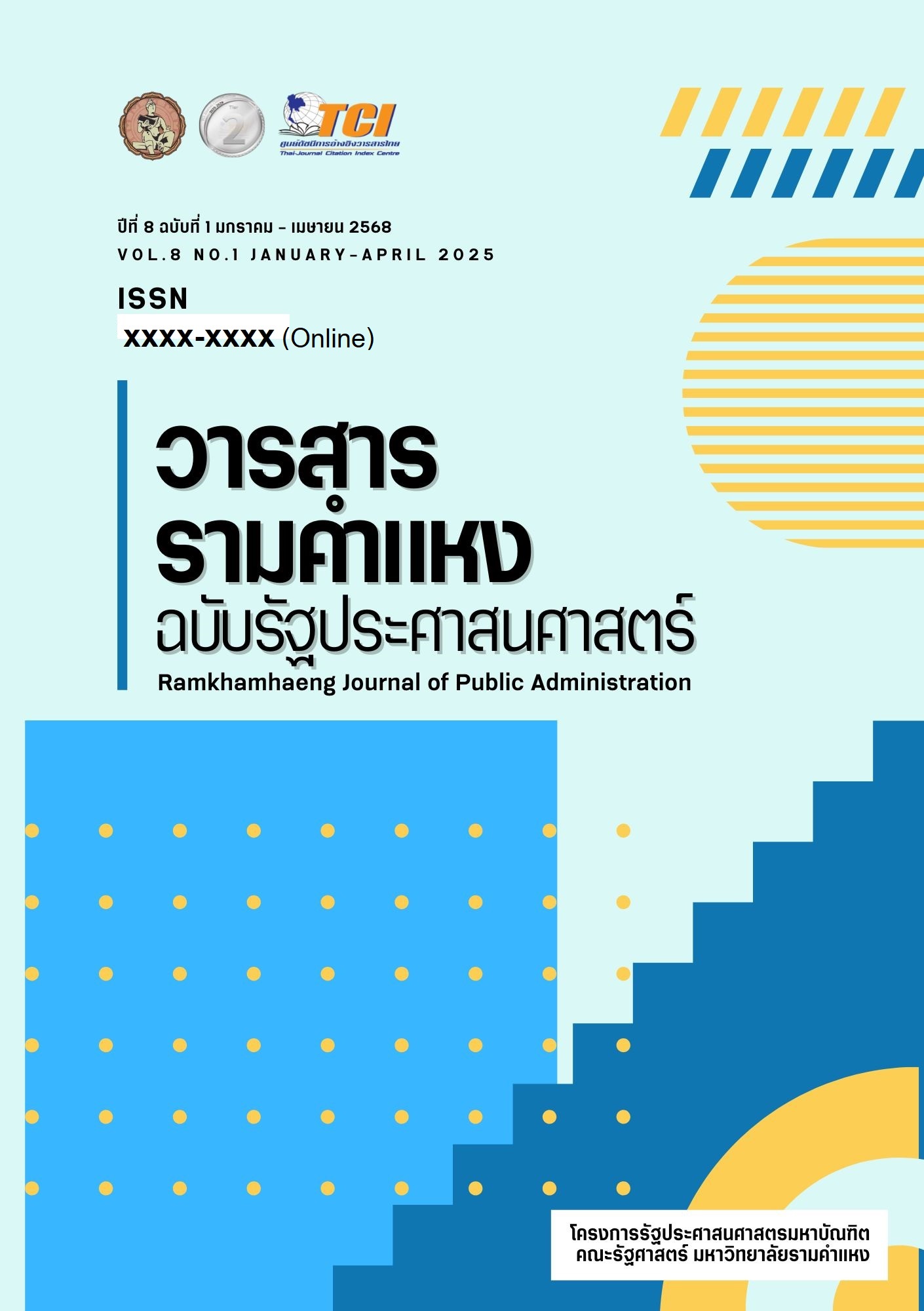New Public Service
A case study of Suanluang District Office, Bangkok
Abstract
This research aimed to study the new public service methods, study the satisfaction of the public towards the new public service, and study the guidelines for the development of the new public service of Suan Luang District Office, Bangkok. This research was qualitative research by analyzing document data and interviewing 9 key informants. The research results found that 1) the public service methods of Suan Luang District Office were consistent with the concept of Denhardt and Denhardt (2008) that the new public service is a tool that can be used to make work more efficient. It has 7 important characteristics as follows: 1.1) Serving citizens, not customers 1.2) Seeking public benefits 1.3) Valuing citizenship more than entrepreneurship 1.4) Thinking strategically and acting democratically 1.5) Realizing that responsibility is not easy 1.6) Providing services more than directing 1.7) Valuing people, not just products 2) The public was satisfied with the new public service methods of Suan Luang District Office, which were consistent with the new public service concept of Denhardt and Denhardt (2008), such as easier access to services, faster service, and responsiveness to needs. Respecting the rights and fairness of the people without emphasizing profit or benefits like entrepreneurs, participating in decision-making, and 3) Guidelines for developing new public services of Suan Luang District Office are consistent with the concepts of Denhardt and Denhardt (2008) as follows: 3.1) Using technology and digital technology, 3.2) Services that are easily accessible, increasing convenient services, 3.3) Improving work processes, reducing complicated work steps, 3.4) Developing infrastructure for convenience and safety, 3.5) Public participation.
References
ฐิติกาญจ์ จำปา. (2567). การบริการสาธารณะแนวใหม่มาใช้พัฒนาระบบบริการประชาชนของสำนักทะเบียนอำเภอเมืองตรัง จังหวัดตรัง. ค้นเมื่อ 28 ธันวาคม 2567.จาก http://www.pol.ru.ac.th/graduate/index.php/is/trang/ trang2-66/6524802247
เดช อุณหะจิรังรักษ์. (2566). เอกสารประกอบการบรรยายกระบวนวิชาขอบข่ายและแนวคิดเชิงทฤษฎีรัฐประศาสนศาสตร์. มหาวิทยาลัยรามคำแหง, โครงการรัฐประศาสนศาสตรมหาบัณฑิต.
เทพศักดิ์ บุญยรัตพันธ์. (2556). แนวคิดการจัดการภาครัฐแนวใหม่กับการบริการสาธารณะ.เอกสารการสอนชุดวิชาการบริหารการบริการสาธารณะ Public Service Administration (พิมพ์ครั้งที่3). นนทบุรี: โรงพิมพ์มหาวิทยาลัย สุโขทัยธรรมาธิราช.
ธัชฎามาศ อุไรวรรณ.(2566).รูปแบบการบริหารจัดการภาครัฐแนวใหม่ที่ส่งผลต่อการจัดบริการสาธารณะเขตเทศบาลนครภูเก็ต จังหวัดภูเก็ต. วารสารการวิจัยการบริหารการพัฒนา, 13 (1), 24-41.
นันทวัฒน์ บรมานันท์. (2554). มาตรฐานใหม่ของการจัดทำบริการสาธารณะระดับชาติในประเทศไทย. กรุงเทพมหาหานคร: สำนักพิมพ์วิญญูชน.
พยุงศักดิ์ ทราบรัมย์.(2557). การนำแนวคิดการบริการสาธารณะแนวใหม่ไปใช้ในการจัดการศึกษาขององค์กรปกครองส่วนท้องถิ่น :กรณีศึกษาเทศบาลในจังหวัดบุรีรัมย์. สืบค้นเมื่อ 28 ธันวาคม2567,จาก https://cuir.car.chula.ac.th/ handle/123456789/46128
วิโรจน์ ก่อสกุล.(2566). เอกสารประกอบการบรรยายกระบวนวิชาองค์การและนวัตกรรมในองค์การ. มหาวิทยาลัยรามคำแหง, โครงการรัฐประศาสนศาสตรมหาบัณฑิต.
วิโรจน์ ก่อสกุล ชลิดา ศรมณี เฉลิมพล ศรีหงษ์ และสิทธิพันธ์ พุทธหุน.(2562). การบริการสาธารณะแนวใหม่ศึกษาเฉพาะกรณีกรุงเทพมหานคร.วารสารรัชต์ภาคย์,13(31), 55-68.
สำนักนายกรัฐมนตรี, สำนักงานสภาพัฒนาการเศรษฐกิจและสังคมแห่งชาติ.(2566).แผนพัฒนาเศรษฐกิจและสังคมแห่งชาติฉบับที่ 13. สืบค้นเมื่อ 28 ธันวาคม 2567, จาก https://www.nesdc.go.th/download/Plan13/Doc/ Plan13_ DraftFinal.pdf
Denhardt and Denhardt (2008).กรอบแนวคิดการบริการสาธารณะแนวใหม่(New public service). สืบค้นเมื่อ 31 ธันวาคม 2567.จากhttps://elcpg.ssru.ac.th/khanthong_ja/pluginfile.php/72/block_html/content/New% 20Public% 20Service.pdf
Downloads
Published
How to Cite
Issue
Section
Categories
License
Copyright (c) 2025 นันทนา ชาวยศ, วีระยุทธ พรพจน์ธนมาศ

This work is licensed under a Creative Commons Attribution-NonCommercial-NoDerivatives 4.0 International License.


